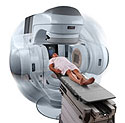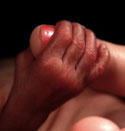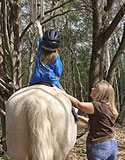QUICKER CANCER THERAPY
 Cancer patients at UAB are the first in the nation to take advantage of a fast, highly accurate form of radiation therapy. The new RapidArc system can deliver treatment in 90 to 110 seconds, compared to the 20 minutes required by conventional technology. And since radiation therapy requires that patients remain very still to avoid damage to the healthy tissues surrounding a tumor, shorter treatment times result in less movement and greater accuracy. They also mean that “patients spend less time and feel less discomfort in the treatment position,” says medical physicist Richard Popple, Ph.D., UAB’s RapidArc team leader. “RapidArc is an important advance for us and our patients,” notes radiation oncologist John Fiveash, M.D. “Knowing that we can reduce delivery times to less than two minutes per day is important, considering what cancer care involves emotionally and physically.”
Cancer patients at UAB are the first in the nation to take advantage of a fast, highly accurate form of radiation therapy. The new RapidArc system can deliver treatment in 90 to 110 seconds, compared to the 20 minutes required by conventional technology. And since radiation therapy requires that patients remain very still to avoid damage to the healthy tissues surrounding a tumor, shorter treatment times result in less movement and greater accuracy. They also mean that “patients spend less time and feel less discomfort in the treatment position,” says medical physicist Richard Popple, Ph.D., UAB’s RapidArc team leader. “RapidArc is an important advance for us and our patients,” notes radiation oncologist John Fiveash, M.D. “Knowing that we can reduce delivery times to less than two minutes per day is important, considering what cancer care involves emotionally and physically.”
PLANET HEALTH FOR PUBLIC HEALTH
Air pollution may trigger more than allergies, according to a new UAB study. Carbon monoxide, a colorless, odorless gas found in car emissions and cigarette smoke, was found to induce the tuberculosis-causing bacterium Mycobacterium tuberculosis to shift from its active form into a dormant, drug-resistant state. Latent tuberculosis tends to escape detection, thus increasing its transmission and contributing to the large number of infections worldwide. The UAB discovery could open new avenues for attacking extremely drug-resistant tuberculosis. It also has “huge socioeconomic and public health implications,” says microbiologist Adrie Steyn, Ph.D., lead author on the study—which suggests that clean-air efforts could offer significant public-health benefits.
TB by the Numbers
- Latent tuberculosis infects an estimated one-third of the world’s population.
- Tuberculosis kills 1.5 million people per year, making it the leading cause of death from a single bacterial infection.
- While the U.S. rate of infection is 4.6 per 100,000 people, TB infection in Alabama is slightly lower at 4.3 per 100,000 people.
FIVE TO THRIVE
Doctors have always used gestational age to judge a premature infant’s chances of survival—and their own strategy for care. But research at UAB and other institutions suggests that four other factors are more important than age alone. According to a study published in the New England Journal of Medicine, preemies are more likely to survive if they are female, from a single birth (that is, not a twin or multiple), have a relatively high birth weight, and if their mothers received steroids to help the baby’s lungs mature before birth. “We knew that the closer a baby was to the 25th week, the better its chances, but it often is hard to calculate a baby’s gestational age,” says UAB’s Wally Carlo, M.D., director of the Division of Neonatology. “It’s easy for a mother’s dates to be off by a week or two, and that could make a large difference in the baby’s chances of survival.” Investigators in the National Institute of Child Health and Human Development Neonatal Research Network presented their findings after observing 4,446 infants born between 22 and 25 weeks. This population was chosen because physicians and parents must make difficult, daily decisions on care for these smallest and most frail of preemies, says Carlo. Using information from the study, a Web tool has been developed at www.nichd.nih.gov to help inform treatment decisions.
A LEG UP
The smallest child can feel eight feet tall sitting on the back of a horse. That experience is the key to the Special Equestrians program at Indian Springs School, which has worked with the UAB/Engel Therapeutic Preschool Program to offer horseback riding classes to emotionally and behaviorally at-risk children. During the 12-week program, children learn to lead, mount, and ride their horses, perform simple exercises and activities, and experience a sensory trail ride. “The children talk to us and interact, answer questions, follow directions—things they didn’t know well when they started,” says Kathleen Claybrook, executive director of Special Equestrians. “They get beyond many of their fears.” Nancy Labriola, a speech and language pathologist and therapeutic preschool teacher at UAB’s Engel Center, says, “For these kids to be doing this is a feat. It gives them something to talk about and something that is special and strictly for them. It’s therapy in itself.”
UNSAFE AT ANY SPEED?
Parents worry when their teenagers get behind the wheel of the family car. A new UAB study suggests that the family golf cart might be just as much of a concern. The docile vehicles are popping up far from their home turf on golf courses, encouraged in many neighborhoods as a way to fight congestion, pollution, and high gas prices. But researchers in UAB’s Center for Injury Sciences found that there were more than 48,255 golf cart-related injuries in the United States between 2002 and 2005, with fractures and head trauma predominant. The highest injury rates were among males 10 to 19 years old and those over 80. “A lot of people perceive golf carts as little more than toys, but our findings suggest they can be quite dangerous, especially when used on public roads,” says epidemiologist Gerald McGwin, Ph.D. Investigators recommend the use of helmets and seat belts due to the high risk of rollover and ejection, along with reevaluations of cart path designs to address high gradients and sharp curves.



